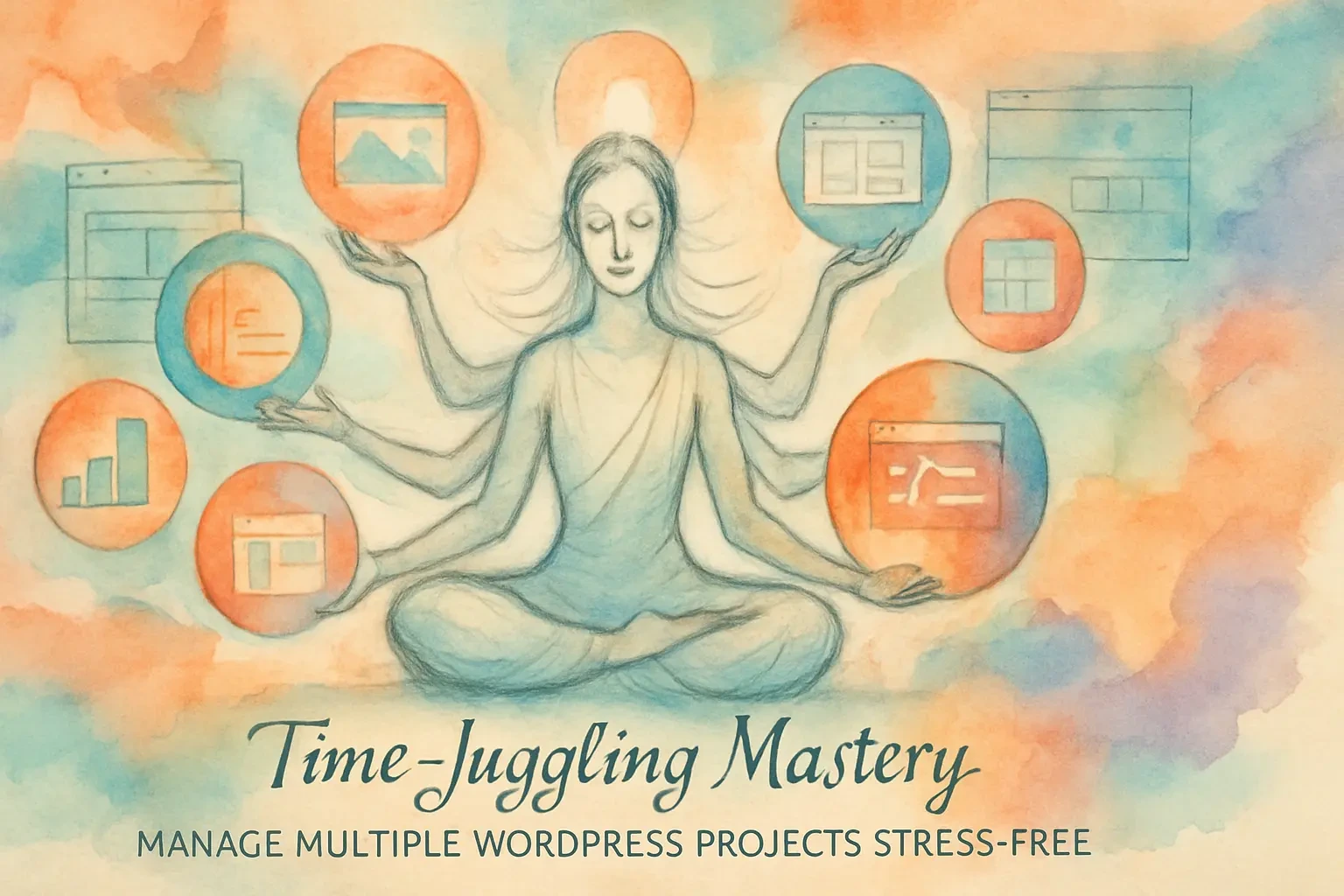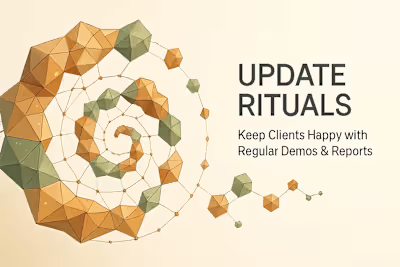Time-Juggling Mastery: Manage Multiple WordPress Projects Stress-Free

Time-Juggling Mastery: Manage Multiple WordPress Projects Stress-Free
The Foundation: Strategic Planning and Prioritization
Break Down Large Projects into Smaller Tasks
Prioritize with the Eisenhower Matrix
Plan Your Week in Advance
Execution: Techniques and Tools for Peak Productivity
Master Time Blocking and Time Batching
Use a Project Management Tool
Track Your Time
Protecting Your Focus and Well-being
Set Clear Boundaries with Clients
Minimize Distractions
Schedule Breaks and Recharge
Conclusion
References
Time-Juggling Mastery: Manage Multiple WordPress Projects Stress-Free
For a successful WordPress freelancer, a full project pipeline is a sign of success, but it can also be a source of immense stress. Juggling multiple clients, deadlines, and development tasks requires more than just hard work; it requires a smart system. Mastering time management allows you to deliver high-quality work on schedule, keep clients happy, and avoid burnout.
It starts with a well-defined project scope established in your contracts and is essential for knowing how to prevent scope creep down the line. When you're ready to expand your workload, you can find your next WordPress project with confidence, knowing you have the systems in place to handle it.
The Foundation: Strategic Planning and Prioritization
Before you can manage your time, you need to know where it should go. A strategic approach to planning your work ensures that you're always focusing on the most important tasks first.
Think of it this way: you wouldn't start building a WordPress site without a clear plan. The same principle applies to managing your workload. Without proper planning, you'll find yourself constantly putting out fires instead of making steady progress.
Break Down Large Projects into Smaller Tasks
A full website build can feel daunting. When a client asks for a complete e-commerce site with custom functionality, your brain might freeze up. Where do you even start?
The secret is breaking each project down into smaller, manageable tasks. Instead of "Build Client X's Website," you create specific action items like:
Design Homepage Mockup
Develop Contact Form
Install and Configure WooCommerce
Set Up Payment Gateway
Create Product Page Template
Install SEO Plugin
This approach makes projects less overwhelming and easier to schedule. You can realistically estimate how long each task will take. Plus, checking off completed tasks gives you a psychological boost that keeps momentum going.
I like to use a simple spreadsheet for this initial breakdown. List every single task you can think of, no matter how small. Then estimate the time for each one. Add a 20% buffer for unexpected issues (because let's face it, there's always something).
Prioritize with the Eisenhower Matrix
Not all tasks are created equal. Some need immediate attention while others can wait. The Eisenhower Matrix helps you distinguish between what truly matters and what just feels urgent.
Here's how it works. Draw a simple grid with four quadrants:
Urgent and Important: Do these tasks immediately. This might include fixing a client's broken checkout page or meeting a launch deadline.
Important but Not Urgent: Schedule these tasks. Think plugin updates, learning new skills, or planning future projects.
Urgent but Not Important: Delegate if possible, or batch these together. These are often interruptions like non-critical emails or minor content updates.
Neither Urgent nor Important: Eliminate these. Scrolling through WordPress forums for fun falls here (save it for after work).
The magic happens when you realize most "emergencies" aren't actually urgent and important. That client email about changing a button color? Important to them, sure, but not urgent enough to derail your current task.
Plan Your Week in Advance
Set aside time every Sunday evening or Monday morning to plan your upcoming week. This isn't just about listing tasks – it's about creating a realistic roadmap.
Start by reviewing all your active projects. Check deadlines, client communications, and project status. Then assign your prioritized tasks to specific days. Be realistic about what you can accomplish. If you know client calls always run long on Tuesdays, don't schedule deep development work right after.
I use a simple system: three main tasks per day, plus smaller administrative items. Any more than that and you're setting yourself up for disappointment. Remember, unexpected issues will pop up. Leave room for them.
Your weekly planning session should also include reviewing the previous week. What worked? What didn't? Did certain tasks take longer than expected? Use these insights to improve your estimates going forward.
Execution: Techniques and Tools for Peak Productivity
With a plan in place, the next step is to execute it efficiently. These techniques and tools are designed to help you stay focused and make the most of your working hours.
The key here is finding what works for your brain and sticking with it. Some developers thrive on variety while others need long stretches of focused time. Experiment until you find your groove.
Master Time Blocking and Time Batching
Instead of working from a simple to-do list, block out specific times in your calendar for specific tasks. This is called time blocking, and it's a game-changer for WordPress freelancers.
Here's what my typical day might look like:
9:00-11:00 AM: Deep development work (Client A's custom plugin)
11:00-11:30 AM: Email and client communication
11:30 AM-1:00 PM: Design work (Client B's homepage mockup)
2:00-4:00 PM: Development work (Client C's WooCommerce setup)
4:00-5:00 PM: Admin tasks and tomorrow's planning
Time batching takes this a step further. Group similar tasks together to reduce context-switching. Handle all client emails in one block. Do all your design work in another. Update all your staging sites at once.
Why does this work? Every time you switch between different types of tasks, your brain needs time to adjust. Jumping from CSS to client emails to PHP debugging wastes mental energy. Batching similar work keeps you in the zone longer.
Use a Project Management Tool
Don't try to keep everything in your head. Your brain is for solving problems, not storing project details. Use a project management tool to visualize your projects and track progress.
Popular options include:
Trello: Great for visual thinkers. Create boards for each client with cards for individual tasks.
Asana: More robust features for complex projects. Excellent for tracking dependencies.
ClickUp: Highly customizable with time tracking built in.
The specific tool matters less than using it consistently. Create separate boards or projects for each client to keep tasks and communication organized. Set up templates for common project types so you're not starting from scratch each time.
Pro tip: Include your clients in the project management tool when appropriate. It reduces email back-and-forth and gives them visibility into progress. Just be sure to set clear expectations about response times.
Track Your Time
Use a time-tracking tool to understand where your hours are actually going. This data is invaluable for improving estimates on future projects and identifying time-wasting activities.
Start simple. Track broad categories at first:
Development
Design
Client Communication
Admin/Business Tasks
Learning/Professional Development
After a few weeks, you'll spot patterns. Maybe you're spending three hours a day on email (yikes!). Or perhaps that "quick" plugin customization regularly takes twice as long as estimated.
This data helps in two crucial ways. First, it improves your project estimates. When you know that contact form development typically takes you 3-4 hours, you can quote accurately. Second, it's essential if you're billing by the hour. No more guessing or undercharging.
Tools like Toggl, Harvest, or even a simple spreadsheet work fine. The key is consistency. Make starting the timer as automatic as opening your code editor.
Protecting Your Focus and Well-being
Effective time management isn't just about productivity hacks; it's also about setting boundaries to protect your most valuable asset: your attention.
Burnout is real in the WordPress freelance world. The always-on nature of web work, combined with client demands and technical challenges, can quickly overwhelm even experienced developers. These strategies help you maintain long-term success.
Set Clear Boundaries with Clients
Communicate your office hours and expected response times in your welcome packet and contract. This prevents clients from expecting you to be available 24/7 and protects your personal time.
Be specific:
"I respond to emails within 24 business hours"
"My office hours are Monday-Friday, 9 AM-5 PM EST"
"Emergency support (site down) is available at a premium rate"
Most clients respect clear boundaries. The ones who don't probably aren't ideal clients anyway. Setting expectations upfront prevents those dreaded Sunday evening "urgent" requests about non-critical changes.
Include your communication preferences too. Maybe you prefer email for project discussions but Slack for quick questions. Or perhaps you batch all calls on specific days. Whatever works for you, communicate it clearly.
Remember: being professional doesn't mean being available 24/7. It means delivering quality work within agreed timeframes.
Minimize Distractions
Identify your biggest distractions and take proactive steps to minimize them. For most of us, the usual suspects include:
Social Media: Use website blockers during work hours. Tools like Freedom or Cold Turkey can lock you out of time-wasting sites.
Email Notifications: Turn them off. Check email at scheduled times instead of every time something lands in your inbox.
Phone Notifications: Put your phone in another room or use Do Not Disturb mode. Every buzz breaks your concentration.
Household Chores: If you work from home, resist the urge to "quickly" do laundry or dishes during work time. These tasks always take longer than expected.
Create a dedicated workspace if possible. When you're in that space, you're working. This physical boundary helps your brain switch into work mode and signals to others (family, roommates) that you're not available.
Schedule Breaks and Recharge
Working non-stop leads to burnout, not better results. Schedule regular breaks throughout your day to stay fresh and focused.
The Pomodoro Technique works well for many developers:
Work for 25 minutes
Take a 5-minute break
After 4 cycles, take a longer 15-30 minute break
During breaks, step away from your screen. Stretch, walk around, or grab a healthy snack. Avoid switching to personal tasks on the computer – your eyes and brain need a real break.
Don't forget about longer breaks too. Schedule at least one full day off per week. Take real vacations where you're completely disconnected from client work. Your creativity and problem-solving abilities improve with proper rest.
Consider your energy levels throughout the day too. Are you sharpest in the morning? Schedule your most challenging development work then. Save routine tasks for your afternoon slump.
Conclusion
Managing multiple WordPress projects doesn't have to mean constant stress and long nights. With strategic planning, the right tools, and healthy boundaries, you can build a thriving freelance business while maintaining your sanity.
Start small. Pick one technique from this article and implement it this week. Maybe it's breaking down your current projects into smaller tasks. Or perhaps it's trying time blocking for the first time.
Remember, the goal isn't perfection. It's progress. Every small improvement in how you manage your time compounds over weeks and months. Soon, you'll wonder how you ever managed without these systems.
Your clients will notice the difference too. When you're organized and focused, you deliver better work faster. That leads to happier clients, better testimonials, and more referrals. It's a positive cycle that starts with taking control of your time.
The WordPress freelance world offers incredible opportunities. With these time management strategies, you can seize them without sacrificing your well-being. Here's to less stress, more productivity, and a freelance career you actually enjoy.
References
Like this project
Posted Jul 6, 2025
Feeling overwhelmed? Learn proven time management techniques and tools to handle multiple WordPress projects simultaneously, reduce stress, and boost your productivity.










